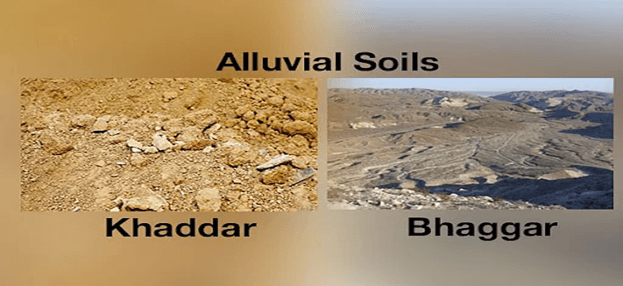Difference between Bhangar and KhadarIndia has two types of soil: Khadar and Bhangar. Alluvial soils like the khadar type are typically found in river floodplains. It is an excellent soil for farming since it is fertile and abundant in organic matter. Bhangar soil, upland soil, can be found at higher altitudes. While it is frequently used for construction, the soil is less productive. Before we move on to the difference between Khadar and Bhangar, let us discuss alluvial soil. 
What is Alluvial Soil?The word "alluvial" comes from the Latin word "alluvius," which means "about a flood." It is related to the word "alluvium," which refers to sediment deposited by a body of water, such as a river or a flood. Alluvial soil is formed by sediment deposited by a river or flood. It is typically found in floodplains and river valleys and is high in nutrients and organic matter. Alluvial soil is fertile and frequently used for agriculture. It is also known for retaining moisture, making it ideal for irrigation. Alluvial soil can be made of various materials, including sand, silt, clay, and rocks. Alluvial soil is formed through alluviation, which occurs when a body of water, such as a river or a flood, carries and deposits sediment in a new location. As the water flows, it picks up soil, rocks, and other materials and transports them downstream. When the water slows down or comes to a stop, it drops the sediment it is carrying, creating a new layer of soil. Over time, this process can lead to thick layers of alluvial soil. The type of alluvial soil that is formed depends on the materials that are carried by the water and the conditions in the area where the soil is being deposited. For example, alluvial soil formed in an area with a high concentration of clay will have a higher clay content than alluvial soil formed in an area with mostly sand. Difference between Bhangar and Khadar
KhadarKhadar soil is a type of alluvial soil found in India's river floodplains. It is fertile, organic-rich soil that is well-suited for agriculture. Khadar soil is typically found at lower elevations of floodplains and is formed by "alluviation", which is the depositing of sediment by a body of water. The water in India's river floodplains transports sediment from the surrounding uplands and deposits it at lower elevations, forming layers of Khadar soil. Khadar soil's fertility is partly due to its high organic matter content, derived from the decomposition of plant material carried by water and deposited in the soil. The organic matter in Khadar soil contributes to the soil's structure, water-holding capacity, and nutrient retention. Properties of Khadar Soil
2. BhangarBhangar soil is a type of soil found in the floodplains of India's uplands. It is found at higher elevations than Khadar soil and lower elevations in floodplains. Bhangar soil is less fertile than Khadar soil and is frequently used for construction. Bhangar soil is formed by weathering, which occurs when wind, water, and other natural forces break down rocks and other materials on the Earth's surface. Weathering can occur over a long period, resulting in the formation of soil that is less fertile than soil formed by alluviation, such as Khadar soil. Bhangar soil is typically made up of clay, silt, and sand, with the addition of rocks and other materials. It is less fertile than Khadar soil in general, but it is still used for some agricultural purposes, such as crop cultivation. Furthermore, because of its strength and stability, Bhangar soil is frequently used in construction. Properties of Bhangar
ConclusionThe major difference between Bhangar and Khadar is that Bhangar soil is less fertile, and Khadar is highly fertile soil. Bhangar and Khadar refer to the two types of alluvial soils found in the North Indian plains. Alluvial soils are deposited in the flood plains by running rivers. Bhangar soil is found in the older parts of the flood plains and is made up of clay and silt. It is less fertile due to its high clay content, which makes it less permeable to water and air. Khadar soil, on the other hand, is found in the newer parts of the flood plains and is made up of mostly sand and silt. It is more fertile due to its higher permeability and the presence of more organic matter. These two types of soil are often found in alternating layers in the North Indian plains and are used for different types of agriculture.
Next TopicDifference between
|
 For Videos Join Our Youtube Channel: Join Now
For Videos Join Our Youtube Channel: Join Now
Feedback
- Send your Feedback to [email protected]
Help Others, Please Share









